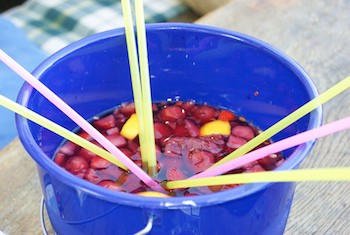Sangria Recipes for a Sweaty Summer
by Diane McMartin

Summer is not a time to fuss. It is not the time to throw a party and spend the whole time sweating through your new sundress because you’re hand-muddling everyone’s organic mango mojitos.
Sangria is the perfect solution — it can be made ahead of time in large quantities and actually tastes better as it sits. No babysitting required! It’s also a good way to showcase seasonal fruit, which conveniently covers up any shortcomings of the cheap wine you bought to make it. I mean, don’t buy Franzia chillable red in a box, but there’s no reason to go crazy with something people will likely end up drinking out of plastic cups.
It also goes nicely with my “less is more” entertaining philosophy. Too many choices make for a dithering, muddled party drinking experience. When people come to my place, they drink what I put out and like it. Did Holly Golightly fuss over making clove simple syrup to orders when she threw that wild party? No, she just looked fabulous.
Rather than recipes to slavishly follow, here are a few ideas for a lighter take on sangria to fortify you for the summer.
RED
A light, young red works best for red sangria. I like to use Schiava, a light-bodied red from northern Italy, but you can use inexpensive Pinot Noir or unoaked Sangiovese, Tempranillo, or Garnacha. Beaujolais Villages also works well. For every bottle, use 1/4 cup fruit liqueur, like creme de cassis or creme de mure. Chambord will do in a pinch, but don’t overdo it, because it’s pretty sweet.
Macerate 1.5 cups of cut up berries, like blackberries, strawberries, or raspberries, in the wine and liqueur for 2–12 hours. Plums and cherries are great choices, too. You can make this ahead of time, but no more than overnight, or softer berries like raspberries will get too mushy. Serve over ice, and fill up the top third of the glass with club soda. If you want to get fancy, you can add a little bit of a nice harmonizing juice like cherry or pomegranate.
The trick with this is to keep everything in the same family. All of these ingredients have flavors in the fresh, ripe berry family. Lots of more traditional sangria recipes call for apples, cinnamon sticks, and/or brandy, but but to me those get a little too boozy and heavy for summer.
WHITE
White sangria is underappreciated and delicious when done right. Some Spanish restaurants often give it all kinds of mismatched, mushy fruit and it gets too sweet, but it doesn’t have to be that way.
I like to start with a crisp, aromatic white. Sauvignon Blanc is ideal, but Torrontes, dry Muscat, or Picpoul de Pinet (a tart, snappy style from the south of France that is usually inexpensive) all work well, too. Something more neutral like Pinot Grigio is OK, too, but isn’t quite as delicious.
Play up the pungent, herbaceous side of Sauvignon Blanc with soft, summer herbs. My favorites are mint and basil. For each bottle of white, add 1/4 cup of orange liqueur like Cointreau, and 1.5 cups of cut up fruit and a cup of herbs of your choice. No need to chop; you want large pieces because they look pretty in the pitcher and won’t get stuck in anyone’s teeth. You can add fruit juice in that same family, too — pineapple, mango, orange, whatever. I don’t like to go too crazy with the juice — half a cup or so will do. For white sangria, I like peaches, nectarines, citrus, and tropical fruit like pineapples or mangoes. The combination of all that musky, heady fruit and and summer herbs smells great, and will make everyone think you worked much harder than you actually did. Macerate for 12–24 hours, and serve the same way as the red — over ice and topped up with fizzy water.
I won’t tell anyone if you decide to skip the party entirely and retire to a hammock with a stack of trashy magazines and a very full glass instead.
Previously: What Goes With Online Shopping?
Photo via eulenfan/flickr.
Diane McMartin is currently working on a book inspired by her Hairpin columns. She’s a Certified Sommelier through the Court of Master Sommeliers and a graduate of a fancy-pants wine and beverage education program in St. Helena, CA. This required many flashcards and a lot of coffee. She lives in the Washington, DC area, where she works in retail teaching wine education classes, helping customers find the perfect wine, and wading through the seemingly endless ocean of bad Chardonnay out there.